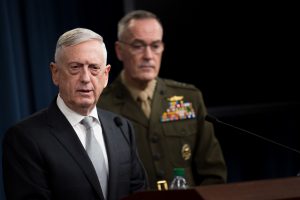Joint Experiments Will Pick Budget Winners & Losers: Dunford
Posted on
ARLINGTON: To cut $33 billion from the 2020 budget – as President Trump has ordered – and still compete against Russia and China, the Pentagon’s political and joint leadership must take a firmer hand with the four armed services, the Chairman of the Joint Chiefs said this afternoon.
The Office of the Secretary of Defense and the Joint Staff must have a clear vision of what future great-power conflict requires, said Gen. Joseph Dunford. They must rigorously test the services’ proposals against that vision, he said, through “much more robust experimentation and wargaming.” Only programs that prove their value should get priority funding.

Secretary of Defense Jim Mattis and the Chairman of the Joint Chiefs of Staff, Gen. Joseph Dunford, brief the press
“Our force development/force design process is changing fundamentally,” Dunford told the Military Reporters & Editors conference here. Instead of just divvying up dollars among the services, Dunford said, “in my judgment, the secretary is going to have to be much more focused in the guidance he gives.”
The Joint Staff has been laboring to translate Defense Secretary Jim Mattis‘s sweeping National Defense Strategy into a detailed “operational concept for employment of the joint force, which we’re coming to closure on right now,” Dunford said. That document will be the baseline against which to assess the services’ programs.
“I will go to the secretary in the coming weeks (with) the priorities” for the next 24 months of exercises and experimentation, Dunford said.
This new process is a profound shift not driven by the immediate exigencies of the budget. It’s necessary, Dunford said, “because the competitive advantage has eroded” against China and Russia. (We’ve been writing about this unnerving trend since 2012). The rise of these two rivals, rapid advances in technology, and metastasizing “trans-regional, all-domain” threats that don’t fit into traditional service or theater frameworks, he said, “make analytical work so much more important than ever before.”
But the Pentagon must compete with the money it’s given, not with the money it would like to have. Senior officials have long warned of a potential crunch in 2020, when the Budget Control Act caps on spending (aka sequester) are set to return, and the Army and Marines have already started systematically purging lower-priority programs.

The aging EC-130 Compass Call electronic warfare (EW) aircraft has struggled with Russian EW in Syria and needs replacement.
True, for fiscal years 2018 and 2019, a spike in spending let the Pentagon invest against a host of urgent shortfalls, Dunford said: “cyber and space, ballistic missile defense, the electromagnetic spectrum, modernization of the nuclear enterprise” — all areas where the shortfalls were so severe that there was “very little danger of overinvesting.” But looking ahead, he said, “it’s fair and proper for us not to expect ever increasing budgets.”
So how does the Defense Department meet rising threats with shrinking funds? Besides day to day support for troops fighting abroad, Dunford said, “the most important effort for us in the Joint Staff” is improving “our linkage between our J-7 and J-8.” What that arcane jargon means is that the experimentation and wargaming — the province of staff section J-7 — must inform resource allocation and force development — the work of J-8.
So when the Defense Department must decide where the next dollar goes — to cybersecurity, say, or more resilient satellites, or stealthier submarines, or better radar jamming — it will make those decisions based on a rigorous analysis of what is required to meet specific campaign objectives.
This kind of systematic, long-term thinking is something the Pentagon neglected amidst the constant crises of the post-9/11 era. “We haven’t done a joint military net assessment for 20 years,” Dunford said. “We didn’t have hot breath on the back of our neck.” Now, he said, with China and Russia increasingly aggressive and sophisticated, we’re feeling that pressure.
Subscribe to our newsletter
Promotions, new products and sales. Directly to your inbox.

